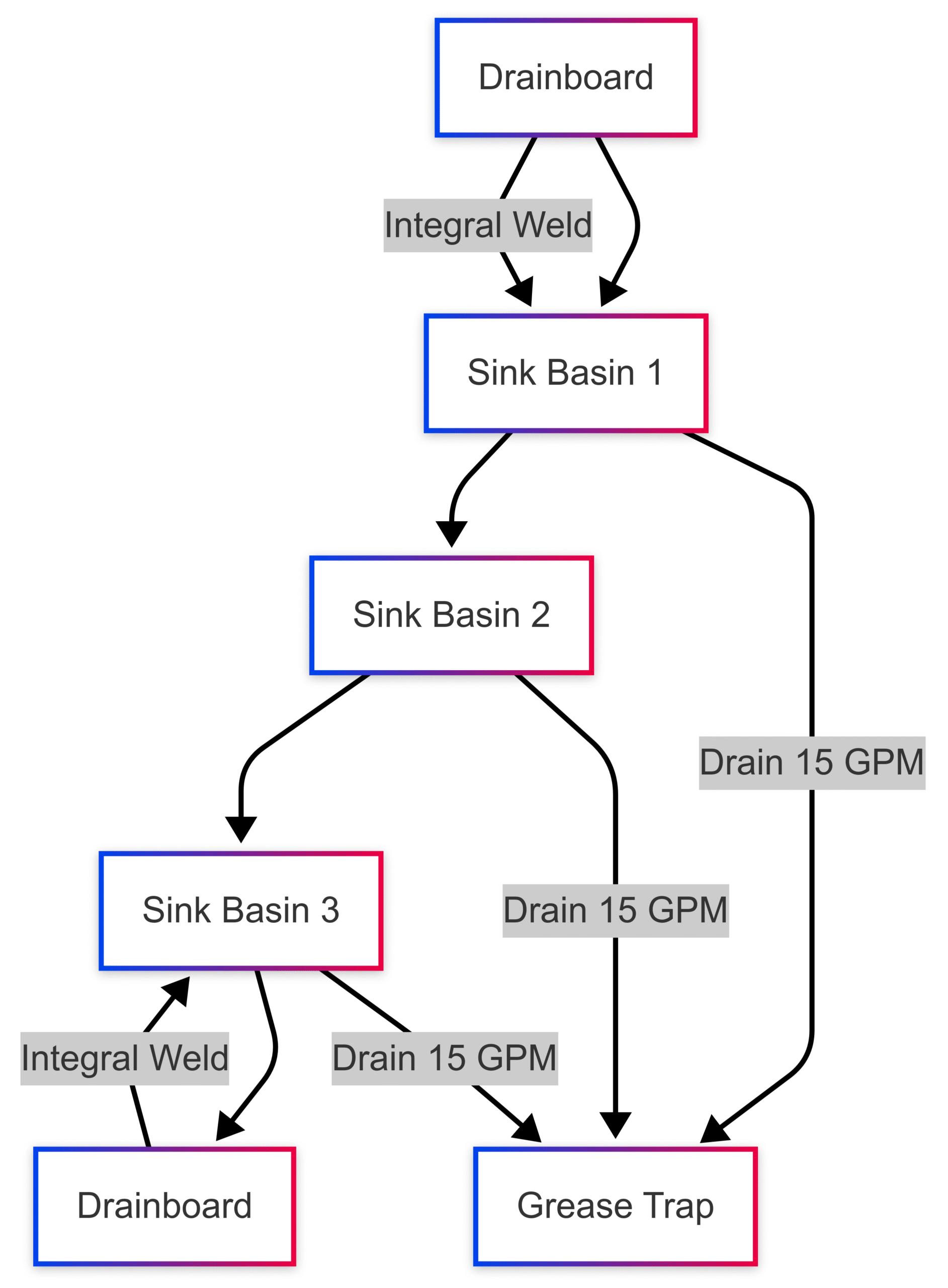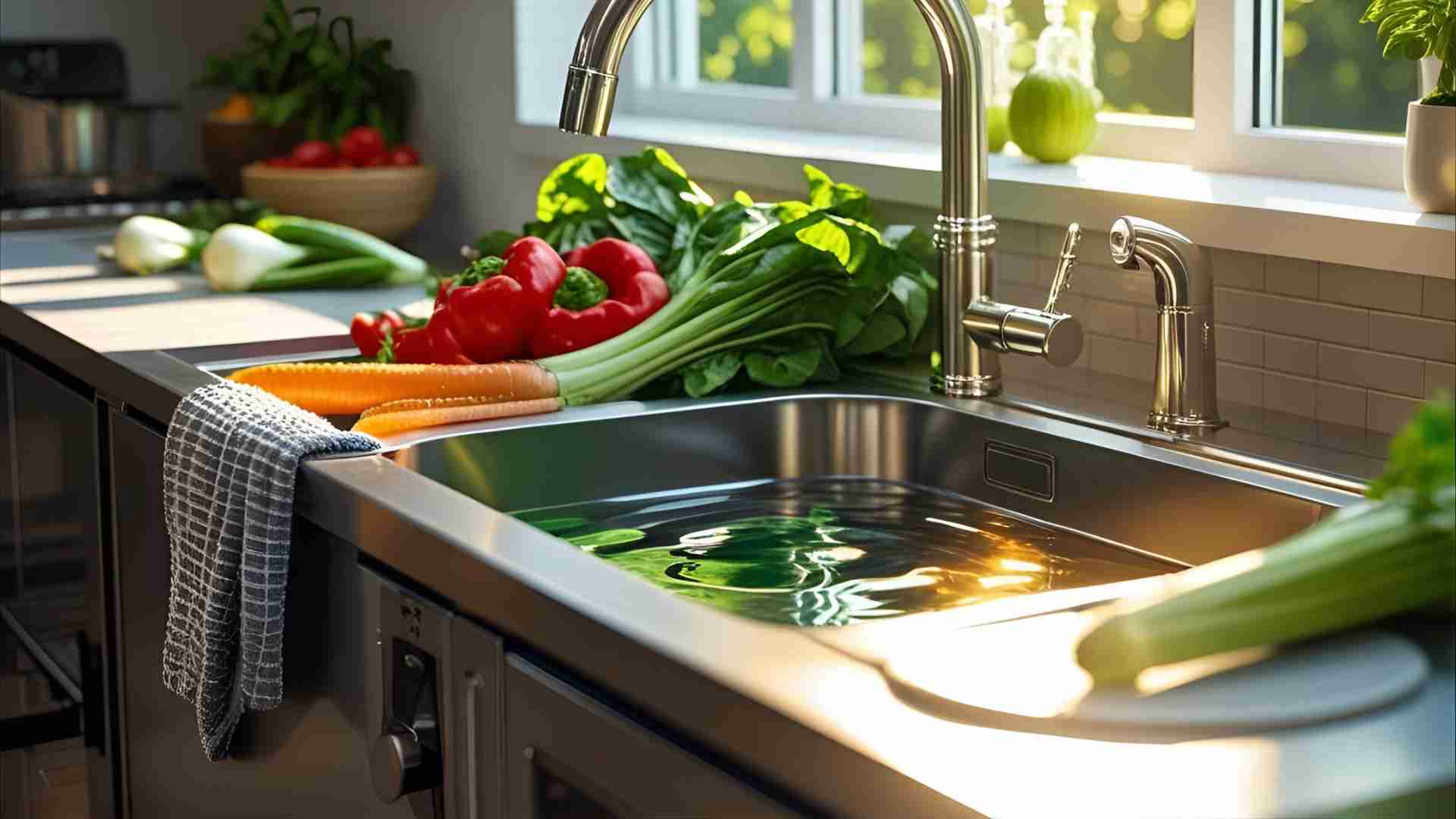what is the volume of a kitchen sink in gallons
Learn how to calculate kitchen sink volume in gallons with formulas, standards, and a sink capacity calculator. Optimize your sink for efficiency!
Understanding the volume of a kitchen sink in gallons is crucial for homeowners, remodelers, and professionals in plumbing or food service. Whether you’re upgrading your kitchen, ensuring compliance with health regulations, or determining if a sink can handle specific tasks like washing machine drainage, knowing a sink’s capacity is essential. This guide provides a detailed exploration of how to calculate sink volume, the standards governing sink design, and practical applications for optimizing sink efficiency. We’ll cover formulas, industry standards, material considerations, and specialized uses, ensuring you have all the tools to make informed decisions.
What is Sink Volume and Why It Matters
Sink volume refers to the amount of liquid, typically measured in gallons, that a sink can hold. This metric is vital for tasks like dishwashing, soaking laundry, or ensuring compliance with regulations in commercial settings, such as food service or mobile food units. Knowing your sink’s capacity helps prevent overflows, ensures efficient water usage, and aids in selecting the right sink for your needs. For example, a homeowner remodeling a laundry room might need to confirm if a sink can handle a washing machine’s drainage, while a restaurant must adhere to NSF standards for food safety.
Key Factors Influencing Sink Volume
Several factors determine a sink’s volume:
- Dimensions: Length, width, and depth directly affect capacity.
- Shape: Rectangular, round, or oval sinks require different calculation methods.
- Material: Stainless steel, porcelain, or composite materials may influence usable volume due to thickness or design.
- Drain Flow Rate: The rate at which water exits the sink impacts its practical capacity.
- Usage Context: Residential, commercial, or specialized applications (e.g., brewing) have unique requirements.
Sink Volume Standards and Specifications
Industry standards provide benchmarks for sink capacities, particularly for commercial applications. Below are standard capacities for deep-drawn and fabricated sinks, as well as drain flow rates and grease trap sizing guidelines.
Deep-Drawn Sink Bowl Capacities
Deep-drawn sinks, commonly used in commercial kitchens, have standardized bowl sizes with corresponding gallon capacities. The following table outlines typical capacities:
| Bowl Size (L x W x D) | Capacity (Gallons) |
|---|---|
| 10″ x 14″ x 5″ | 2.75 |
| 10″ x 14″ x 10″ | 5.50 |
| 14″ x 16″ x 10″ | 9.35 |
| 14″ x 16″ x 12″ | 11.25 |
| 16″ x 20″ x 12″ | 15.70 |
| 16″ x 20″ x 14″ | 18.40 |
Fabricated Sink Capacity Formula
For fabricated sinks (models FC, FS, and FE), the capacity can be calculated using the formula:
Capacity (Gallons) = (Length x Width x Depth) ÷ 231
Here, 231 represents the number of cubic inches in one U.S. gallon. For example, a sink measuring 16″ x 20″ x 12″ would have a capacity of:
(16 x 20 x 12) ÷ 231 = 3,840 ÷ 231 ≈ 16.62 gallons
Drain Flow Rates
The drain’s flow rate determines how quickly water exits the sink, which is critical for preventing backups, especially in high-drainage scenarios like washing machine use. Common drain models include:
| Drain Model | I.P.S. Size | Drain Flow (GPM) |
|---|---|---|
| K-6 (Basket) | 1-1/2″ | 7 |
| K-5 (Twist) | 1-1/2″ | 7 |
| K-15 (Twist) | 2″ | 15 |
Grease Trap Sizing
In commercial kitchens, grease traps prevent fats, oils, and grease from entering the plumbing system. The sizing formula is:
Grease Trap Size (Pounds) = 1.5 x Number of Compartments x Drain Flow (GPM)
The 1.5 factor accounts for 75% of the sink’s volume multiplied by a conversion factor (K = 2) for volume-to-weight. For a three-compartment sink with a 15 GPM drain:
1.5 x 3 x 15 = 67.5 pounds
NSF Requirements for Sinks
The National Sanitation Foundation (NSF) sets standards for sinks in food service environments:
- Drainboards: Must be integrally welded with a splash guard and have a left-to-right dimension equal to or greater than the smaller dimension of the sink bowl.
- Materials: Only 200, 300, or 430 series stainless steel is approved for food zones. Types 400 and 409 are not acceptable.
- Sanitizing: A solution of 50 ppm chlorine (e.g., 1 oz of 5% household bleach per 7.8 gallons of water) is recommended for warewashing.
The table below shows bleach requirements for various sink sizes:
| Bowl Size (L x W) | Depth | Bleach Solution (Ounces) |
|---|---|---|
| 10″ x 14″ | 10″ | 0.70 |
| 14″ x 16″ | 12″ | 1.50 |
| 16″ x 20″ | 12″ | 2.00 |
| 20″ x 20″ | 12″ | 2.60 |
| 24″ x 24″ | 12″ | 3.20 |
| 20″ x 28″ | 12″ | 3.60 |
Calculating Sink Volume: Formulas and Methods
Calculating the volume of a sink is straightforward with the right formula, depending on the sink’s shape. Below, we outline methods for rectangular and round sinks, as well as considerations for multi-basin sinks and specialized applications.
Rectangular or Square Sink Capacity
Most kitchen sinks are rectangular, making this the most common calculation. The formula is:
Capacity (Gallons) = (Length x Width x Depth) ÷ 231
- Length: Measure from the left to right inside edge of the sink bowl.
- Width: Measure from the back to front inside edge.
- Depth: Measure from the bottom to a point slightly below the top rim (to account for practical fill levels).
Example: For a sink measuring 20″ x 16″ x 12″:
- Volume = 20 x 16 x 12 = 3,840 cubic inches
- Capacity = 3,840 ÷ 231 ≈ 16.62 gallons
For double or triple-basin sinks, calculate each basin individually and sum the capacities. For a three-basin sink with each basin at 10″ x 14″ x 10″:
- Single basin = (10 x 14 x 10) ÷ 231 = 1,400 ÷ 231 ≈ 6.06 gallons
- Total = 6.06 x 3 ≈ 18.18 gallons
Round or Oval Sink Capacity
Bathroom sinks are often round or oval, requiring a different formula:
Capacity (Gallons) = (Radius x Radius x Depth x 3.14) ÷ 231
- Radius: Measure from the center to the edge of the sink.
- Depth: Measure from the bottom to just below the top rim.
- 3.14: Represents pi, used for circular calculations.
Example: For a round sink with a 10″ diameter (radius = 5″) and 6″ depth:
- Volume = 5 x 5 x 6 x 3.14 = 471 cubic inches
- Capacity = 471 ÷ 231 ≈ 2.04 gallons
Practical Considerations
When calculating, avoid filling the sink to the brim to prevent spills. Subtract 1-2 inches from the depth for a realistic capacity. Additionally, account for drain flow rates when selecting a sink for high-drainage tasks, such as washing machine discharge, which may require a minimum flow rate (e.g., 17 GPM for some machines).
Specialized Applications: Washing Machine Drainage
A common concern, especially during home renovations, is whether a sink can handle the drainage from a washing machine. For example, a user remodeling a second-floor laundry room might opt for a narrow, deep sink (e.g., 7″ x 16″ x 7.5″) with a capacity of:
(7 x 16 x 7.5) ÷ 231 = 840 ÷ 231 ≈ 3.64 gallons
However, washing machines often discharge water at high rates (e.g., 17 GPM, as per some manuals). The sink’s drain must handle this flow to prevent backups. A 1-1/2″ pipe with a 7 GPM drain (e.g., K-6 or K-5) may be insufficient, while a 2″ pipe with a 15 GPM drain (e.g., K-15) is closer to the requirement. In this case, the 3.64-gallon sink may be too small, risking overflow during rapid discharge. A larger sink (e.g., 18 gallons, as in a 20″ x 20″ x 15″ utility sink) is safer, especially if the drain line connects to other fixtures (e.g., bathroom sink, kitchen sink, or dishwasher).
Recommendation: For washing machine drainage, prioritize a sink with at least 10-15 gallons capacity and a 2″ drain with 15 GPM flow. Consult local plumbing codes and a professional plumber to ensure compliance and functionality.
Material Considerations and Corrosion Prevention
The material of a sink affects its durability and suitability for specific environments. Stainless steel, particularly 304 series, is recommended for its corrosion resistance, especially in challenging conditions like:
- Well Water: High sediment can accelerate wear.
- Coastal Areas: Salt air increases corrosion risk.
- High Humidity: Common in southern regions, promoting rust.
- Chlorinated Sanitizers: Used in food service, can degrade lower-grade materials.
Corrosion Prevention Tips:
- Use 304 stainless steel for sinks in food service or harsh environments.
- Implement a regular maintenance program, including cleaning with non-abrasive solutions.
- Avoid prolonged exposure to chlorinated chemicals beyond the recommended 50 ppm (e.g., 1 oz of 5% bleach per 7.8 gallons).
Sink Types and Their Capacities
Kitchen sinks come in various configurations, each with unique capacity characteristics:
- Single-Basin Sinks: Ideal for large items (e.g., pots), offering high capacity (e.g., 15-20 gallons for a 24″ x 20″ x 12″ sink).
- Double-Basin Sinks: Provide versatility but smaller individual basin capacities (e.g., 6-8 gallons per basin).
- Farmhouse Sinks: Deep and wide, often exceeding 20 gallons, perfect for heavy-duty tasks.
- Undermount Sinks: Sleek but vary widely in capacity based on design.
Example Product: A large-capacity portable hand wash station (42″ x 24″ x 54″) offers:
- 47 gallons grey water capacity
- 43 gallons fresh water capacity
- Price: $150/week (includes delivery, setup, and disposal)
Visualizing Sink Configurations
To illustrate sink configurations, we can use a diagram to show the layout of a three-basin sink with drainboards, as required by NSF standards.

This diagram shows a three-basin sink with drainboards on both ends, each basin connected to a grease trap via 15 GPM drains, adhering to NSF requirements.
Sink Capacity Calculator: A Practical Tool
A sink capacity calculator simplifies volume calculations. Here’s how to use it:
- Select Shape: Choose rectangular or round.
- Enter Dimensions: Input length, width, and depth (or radius for round sinks) in inches.
- Calculate: The tool divides the cubic volume by 231 to provide gallons.
Example: For a rectangular sink (20″ x 16″ x 12″):
- Input: L = 20, W = 16, D = 12
- Output: 16.62 gallons
For a round sink (10″ diameter, 6″ depth):
- Input: Radius = 5, Depth = 6
- Output: 2.04 gallons
This tool is invaluable for homeowners, contractors, or food service operators needing quick, accurate estimates.
Regulatory Compliance for Mobile Food Units
Mobile food units, such as food trucks, must comply with health regulations like § 5-305.11(A), requiring:
- Handwashing: Minimum 5 gallons of water.
- Warewashing: Minimum 30 gallons or twice the volume of a three-compartment sink, whichever is greater.
For a three-basin sink with 6.06 gallons per basin (18.18 gallons total), the warewashing requirement is:
2 x 18.18 = 36.36 gallons
Thus, the unit must have at least 36.36 gallons of fresh water for warewashing, plus 5 gallons for handwashing, and additional water for food preparation (menu-dependent).
Optimizing Sink Efficiency
To maximize sink efficiency:
- Match Capacity to Task: Ensure the sink’s volume suits its primary use (e.g., dishwashing, laundry, or commercial food prep).
- Balance Flow Rate: Pair high-capacity sinks with drains that handle rapid water flow (e.g., 15 GPM for commercial use).
- Regular Maintenance: Clean sinks with appropriate solutions to prevent corrosion and maintain capacity.
- Professional Consultation: For complex setups (e.g., washing machine drainage or commercial kitchens), consult a plumber to verify drain compatibility and code compliance.
Conclusion
Calculating the volume of a kitchen sink in gallons is a fundamental skill for optimizing kitchen functionality, ensuring regulatory compliance, and preventing plumbing issues. By understanding sink dimensions, shapes, materials, and drain flow rates, you can select the right sink for your needs, whether for residential, commercial, or specialized applications. Use the provided formulas, standards, and tools like the sink capacity calculator to make informed decisions. For complex installations, always consult a professional to ensure safety and efficiency. With this knowledge, you’re equipped to enhance your kitchen’s performance and meet any challenge head-on.
Please share this what is the volume of a kitchen sink in gallons your friends and do a comment below about your feedback.
We will meet you on next article.
Until you can read, What material pans to use with glass-ceramic cooktop?






